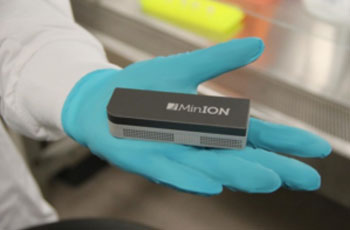Portable DNA Sequencer Functions Well in Evaluation Trials
By LabMedica International staff writers
Posted on 06 Apr 2015
Researchers have demonstrated the ability of a handheld nanopore sequencer to accurately identify and differentiate bacterial and viral samples.Posted on 06 Apr 2015
The Oxford Nanopore Technologies (Oxford, United Kingdom) MinION nanopore sequencer was recently released to a select group of investigators for evaluation using a variety of sequencing applications.

Image: Close up of the MinION nanopore sequencer (Photo courtesy of Dr. Andrew Kilianski, Edgewood Chemical Biological Center).
MinION rapidly determines the sequence of subject DNA through the application of protein nanopore technology. The method is based on a protein channel—only a few nanometers in diameter—through which a single strand of DNA can pass. As the DNA strand passes through the nanopore, it generates a series of characteristic electrical signatures, from which nucleotide bases can be identified, and the sequence of the strand determined. The instrument is powered and operated by a laptop computer via a USB connection.
Some teams of evaluators tested the ability of the MinION to act as a whole genome sequencer and demonstrated that nanopore sequencing has tremendous potential utility. However, the current nanopore technology still has limitations with respect to error-rate, and this is problematic when attempting to assemble whole genomes without secondary rounds of sequencing to correct errors. In the current study, investigators at Edgewood Chemical Biological Center (Edgewood, MD, USA) and Signature Science, LLC (Austin, TX, USA) tested the ability of the MinION to accurately identify and differentiate bacterial and viral samples via directed sequencing of characteristic genes.
They reported in the March 26, 2015, edition of the journal GigaScience that by using a six hour sequencing run time, sufficient data were generated to identify an E. coli sample down to the species level from 16S rDNA amplicons. Three poxviruses (cowpox, vaccinia-MVA, and vaccinia-Lister) were identified and differentiated down to the strain level, despite over 98% identity between the vaccinia strains. The ability to differentiate strains by amplicon sequencing on the MinION was accomplished despite an observed per-base error rate of approximately 30%.
First author Dr. Andrew Kilianski, a researcher at Edgewood Chemical Biological Center, said, "Our findings are important because we have for the first time communicated to the community that this technology can be incredibly useful in its current state. Being able to accurately identify and characterize strains of viruses and bacteria using a mobile platform is attractive to anyone collecting biological samples in the field. And we expect that as the technology improves, the sequencing will generally become cheaper, faster, and more accurate and could have further clinical applications."
Related Links:
Oxford Nanopore Technologies
Edgewood Chemical Biological Center
Signature Science, LLC













